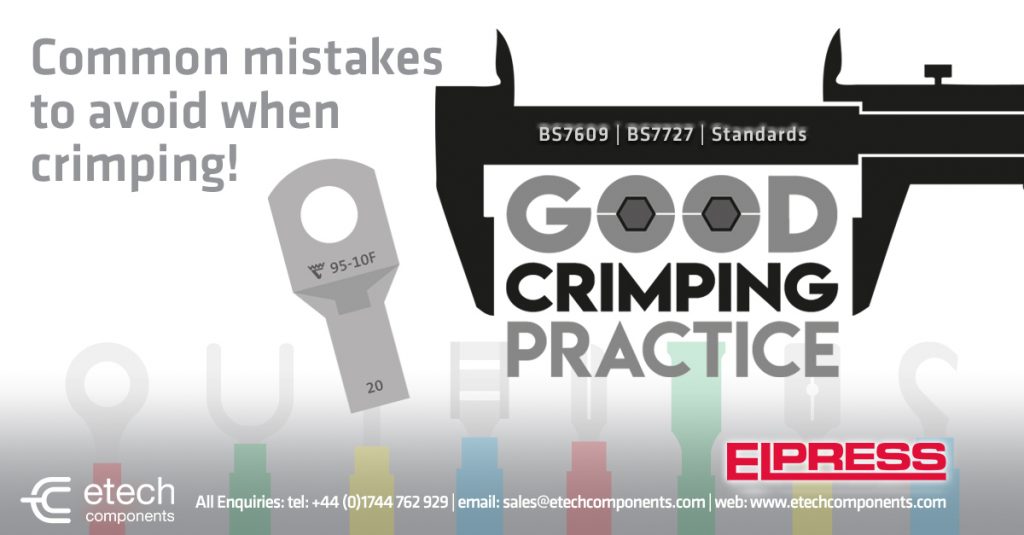Common Mistakes & Good Crimping Practice Campaign
Elpress are world leaders in Quality Crimping Systems and have been trying to raise awareness of the poor quality products and crimping practice in the UK for many years. E-Tech Components, the UK Distributor for Elpress Crimping Systems, are launching a Good Crimping Practice Campaign to highlight issues relating to the lack of awareness in the Electrical Industry of the relevant IEC standards for manufacturing of Crimping Systems and also the BS Codes of Practice for Crimping installations.
Sadly, the lack of awareness of crimping issues and the application of bad crimping techniques are widespread in all sectors of the industry. There is growing evidence that the aforementioned have contributed to Switchgear and Substation failures. Apart from being a quality issue it also has Health & Safety implications and potential fire risks. Below are some of the biggest and most common mistakes made, bad practices followed and electrical crimping techniques applied in the industry:
Standards are always out of date. That’s what makes them standards. (Alan Bennett)
The IEC standard is a much more comprehensive and demanding test of manufacturing, involving both mechanical and electrical performance of a Crimping System. Whereas, BS4579 focused mainly on mechanical strength, measured alone by a pull off test.
Another misconception of the industry is that the Standards of Electrical Crimping only refer to larger lugs. Actually, the Principles of Good Crimping apply to all lug sizes and types. Not just large copper tube terminals but also to small sizes under 10mm2. Although there is a separate Code of Practice (BS7727), the same principles of a “systemic” approach apply.
Buying Cheap Lugs from Unknown Manufacturers with no Markings
Let us make a parallelism here. You are at the supermarket with your hungry son and you are facing a dilemma as there are two types of apples. One of them is within a quality packaging, has clear markings of the origin of the apple, the name of the supplier, the expiry date and all. The second ones have an odd shape, each apple has a slightly different colour, no packaging whatsoever and no markings at all, but they are cheaper. Which apple will you get for your son? Is there even really a dilemma??
Sometimes, the physical dimensions and the lack of markings on some lugs available in the market, makes it obvious that they would never comply to the IEC Standard or the BS Code of Practice, which clearly stipulate the marking of lugs, dies and tooling to ensure a systematic approach. These poor quality terminals are widely available across the supply chain in the industry coming from unknown manufacturers and people still buy them because of their price. These people will discover the hard way how the bitterness of poor quality remains long after the sweetness of low price is forgotten.
The samples above are all Lugs from different “Manufacturers” / Importers / Suppliers. It is obvious that there are considerable differences both on the barrel size and the amount of copper the lugs are made of, hence they all have a different current-carrying capacity and other divergent features. Additionally, it is clear and obvious that crimping can not take place for all of these with the same tool. Doing so would potentially result in the serious consequences of either over-crimping or under-crimping.
Mixing & Matching Cable Lugs & Crimping Tools
Most of the suppliers of Cable Crimp Lugs and Crimping Tools in the UK are not manufacturers, but importers of Crimp Lugs from one source (manufacturer A) and Tooling from a different one (manufacturer B). This raises questions on whether there has been any testing on the chosen Lug and Tool and how safe is it to combine Lugs of manufacturer A with Tools from manufacturer B. Many contractors and OEM’s routinely “mix and match”, perhaps by purchasing the lugs from a local wholesaler and then hiring a tool from a plant hire company, or using whatever tool is to hand to carry out the crimp. These are the same people that if asked about standards, would refer to the old BS4579 standard, if any standards at all.
For some unexplained reason there is a belief in the industry that all Cable Terminals are the same and that different manufacturers’ Tooling and Terminals are interchangeable (definitely NOT the case). Each manufacturer’s terminals have different dimensions so “mixing and matching” of tooling risks over- or under-crimping with all the potential dangerous consequences of that, and with no standards to fall back on in the event of a fault.
Stepping up/ down a Lug Size
From our market research it is clear that combining terminals and tooling is common practice, and so is stepping up or down a terminal size depending on the class of cable. For example a contractor will purchase the lugs from a local wholesaler and then hire an electrical crimping tool from a plant hire company, or use whatever tool is to hand to carry out the crimp. Then, if the terminal seems a tight, or loose fit, they will ‘step up’ or ‘step down’ a size of terminal depending on what Class of cable it may be. This clearly contravenes the code of practice, violates the IEC Standards and could lead to failures and catastrophic accidents.
Cutting Strands of cable that don’t fit & Filing off wings caused by overcrimping
Another unfortunately common practice is snipping off strands of cable that don’t fit into the lug or filing off “wings” caused by overcrimping. This significantly reduces the current carrying capacity of both the cable and the lug! Most electricians we spoke to, say this is what they were taught to do during their apprenticeship. This just highlights the lack of training provided in such a key area as crimping on a cable installation.
Electricians need to train on how to use a drill on a site but not on how to use a Hydraulic Crimp Tool, that can provide 25 tonnes of pressure (or more) and used on a 33KV cable installation! Elpress believe that training is the key to raising standards and stress that the most important component of a good quality crimped connection is… the TRAINED Operator!
LSOH Cable terminated with PVC insulated Terminals
During our visits to sites, we have some times witnessed absurd and unexplained things. One of the strangest ones would be PVC insulated terminals at the end of LSOH specified cable… Which translates to the investment of thousands of pounds on Low Smoke Zero Halogen cable (well done for this)…. BUT someone decided to use a plastic terminal at the most important part, the cable’s the connection with the Switch-gear!!!
Good Crimping Practice Campaign
Sadly, the lack of awareness of crimping issues and the application of bad crimping techniques like the ones above are widespread in all sectors of the industry from the electricians and consultants to contractors and major OEM’s. This dangerous situation will only be solved if as much care is taken in specifying the Crimping products and accessories as is given to the Switch-gear and the Cable itself. After all, the system is only as strong as its weakest point!
As part of this campaign, E-Tech Components are offering:
- Lunch and Learn Seminars covering the standards and good crimping practices
- Free Certified Training whenever you purchase one of our Elpress Crimping Tool Systems
- On-site Inspection and Assessment of companies current Crimping Systems and procedures
- Free Advice on how to ensure compliance to the standards.
Follow links for more Blog Posts/ Articles on: Crimping, Tooling, Standards & Regulations.

